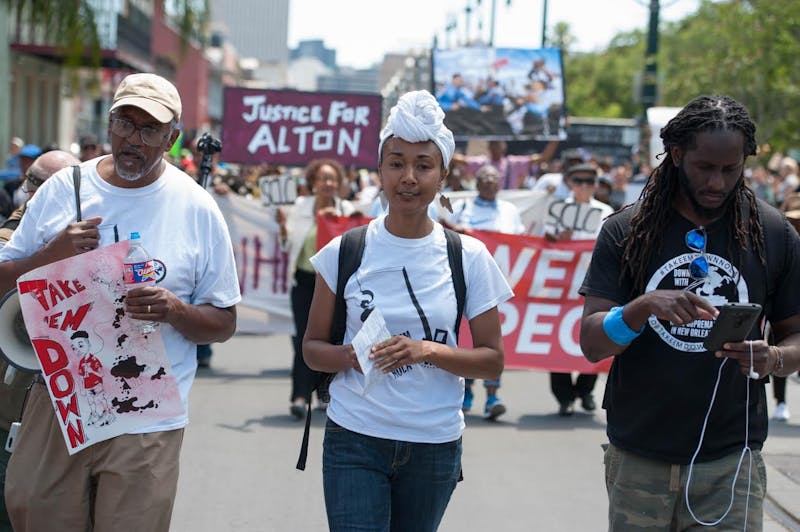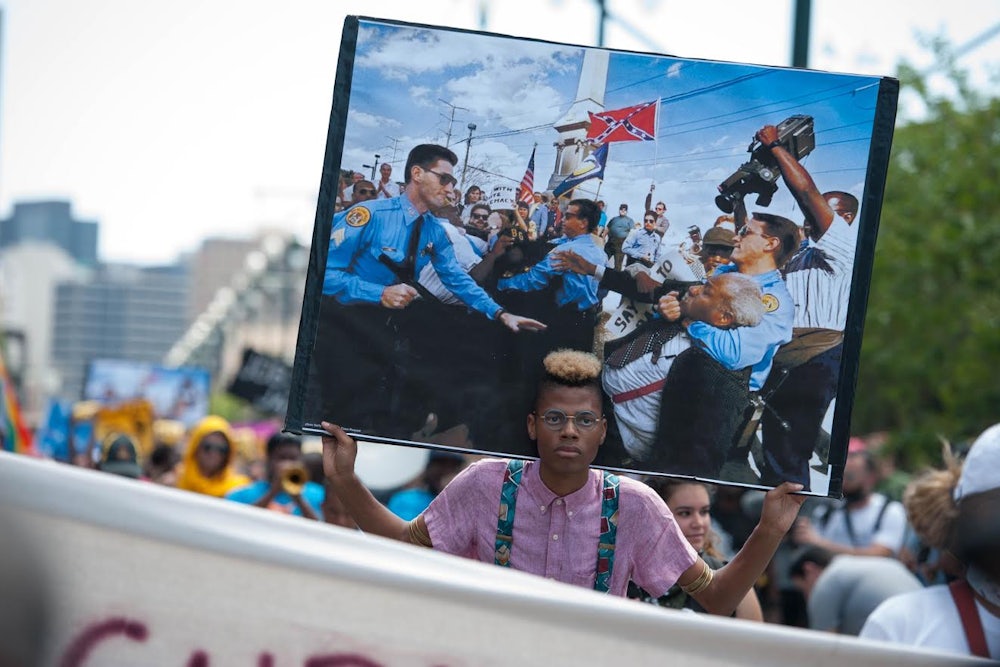In 1811, Charles Deslondes, a mixed-race slave driver from Saint-Dominique, Haiti, led what would become the largest slave rebellion in American history. Composed of 500 men, many of whom had participated in the successful Haitian revolution only a few years prior, Deslondes’s army advanced on New Orleans with a military discipline that surprised many of their adversaries. As they marched along the Mississippi River—drums rumbling, flags held high above their heads—they attacked several plantations with an assortment of scavenged weapons. Within 48 hours, local militia and federal troops had suppressed the rebellion and Deslondes was ruthlessly executed—his hands were chopped off, he was shot in both legs, and then burned to death in a bale of straw.
The rebellion’s import has changed over time. In the immediate aftermath, the backlash was brutal. Alarmed slaveholders in Louisiana invested resources in training local militia, and slave patrols began surveying slave quarters with increasing frequency and ruthless violence. Meanwhile, the federal government realized that in order to defend Louisiana, it would also have to defend the institution of slavery. It formalized this commitment in 1812, when the United States officially granted Louisiana statehood. Louisiana remained a state until 1861, when it seceded from the Union. There is no doubt why it did this, as its leaders said so explicitly: “Louisiana looks to the formation of a Southern confederacy to preserve the blessings of African slavery.”
Today, the rebellion of 1811 is a historical cornerstone in an ongoing attempt to foster an honest reckoning with the past. Last week, a statue of Confederate leader Jefferson Davis, originally erected in 1911, was removed in New Orleans. This week, an equestrian statue of the Confederate general P.G.T. Beauregard was also pulled down by authorities. Along with the removal of a monument to the Battle of Liberty Place, which commemorated a Reconstruction-era insurrection by white supremacists, three of a planned four monuments have been taken down. At the forefront of the effort to have the statues removed is a group of young, black activists known as Take ‘Em Down NOLA.
Michael “Quess?” Moore, an educator, poet, and playwright, has become one of the faces of this movement. On a recent evening in his New Orleans home, his long dreadlocks draped over his shoulders and chest, he told me what had inspired him to get involved in this project, his stories moving fluidly between past and present. When he moved to New Orleans, Moore, originally from Brooklyn, attended a lecture by two black New Orleans historians, Malcolm Suber and Leon Waters, to whom he attributes the development of much of his political education. Suber and Waters, who run a tour in New Orleans called “Hidden Histories,” have made it their mission to bring to light the parts of black history in the Crescent City that you won’t find in your typical textbook, including Deslondes’s rebellion.
“Malcolm and Leon had this kind of pedagogy that was integrated into organizing work and a Marxist/Leninist framework … then taking that and integrating it with black history and what it meant for black people to live under systemic oppression,” Moore says, shaking his head as if he should have made the connection himself long ago. He says they pointed to those monuments of Davis and others and told him, “‘Okay, this shows you what the state thinks about you; this shows you what the state thinks about the system that oppressed your ancestors and how they still feel about it to this day.’” He pauses and raises his hands on either side of him. “Long story short, it just all clicked for me.”
Moore is far from alone in this sentiment. For Angela Kinlaw, a co-founder of the organization who works as an educator in New Orleans, the relationship between the monuments and an enduring racism is clear. “Symbols are used to bond people around cultural values, ideas, political ideologies, and those ideas show up in systems that are protected by the state,” she told me early one morning before attending the graduation ceremony for her students. “When we look at our environment and we see that all of the major street names, all of the most revered monuments, all the parks that these kids and families are playing in … All of this stuff is messaging, all of this stuff is psychological, all of this stuff has an impact.”
For Kinlaw, Moore, and many young activists in New Orleans and around the country a painful confluence of events—Trayvon Martin’s death, Ferguson’s uprising, Dylann Roof’s massacre—created a storm of political outrage that has started to convene around enduring symbols of white supremacy, like the Confederate monuments. Dylann Roof’s 2015 attack on members of a black church in Charleston, South Carolina, which led to the removal of a Confederate flag at the South Carolina State House, may have been the final catalyst needed to push for the removal of the monuments in New Orleans. At the same time, to see the Charleston massacre as the sole cause would negate the work that activists in New Orleans have been doing for years.

Take ‘Em Down NOLA began as a loose collection of activists, many of whom had been involved in other local and national racial justice organizations like the Black Youth Project. Moore describes it as “a black-led, multiracial, intergenerational coalition,” with a strong emphasis on intersectional awareness. He reminds me the organization wouldn’t exist without Kinlaw and other women who have been on the frontlines of this work. “Even our elders, as an intergenerational coalition, I watch get somewhat of an education on this,” he says. “[Men] gotta learn how to step back, right? Because that’s what damaged a lot of the movements in the past.”
Take ‘Em Down NOLA was birthed out of a recognition that the Confederate statues were the physical manifestation of an ahistorical worldview, one which valorized and apologized for the very champions of slavery. The group does not equivocate about its purpose:
We the people of New Orleans demand that the Mayor and City Council take immediate action to remove all monuments, school names and street signs dedicated to White Supremacists. These structures litter our city with visual reminders of the horrid legacy of slavery that terrorized so many of this city’s ancestors. They misrepresent our community. We demand the freedom to live in a city where we are not forced to pay taxes for the maintenance of public symbols that demean us and psychologically terrorize us.
Kinlaw emphasizes that when the group says all, it means all.
The organization identified more than 100 statues, 24 streets, seven schools, and two hospitals that it says pay tribute to slavery. These include Tulane University, named after Paul Tulane, who was the largest donor to the Confederacy in New Orleans; several schools named after John McDonogh, who was a prominent slave owner in the city; and Governor Nichols Street, named after a Confederate general.
After the Charleston massacre, New Orleans Mayor Mitch Landrieu called for the removal of four statues: Robert E. Lee, P.G.T. Beauregard, Jefferson Davis, and the monument commemorating the Battle of Liberty Place. “Those were easier to stigmatize because they were all in the Confederacy,” Moore notes. I ask him about the possibility of removing the statue of President Andrew Jackson—a slaveholder who also presided over the Trail of Tears—in the middle of the French Quarter. Moore laughs, “When it’s Jackson, now you’ve gotta have a larger conversation.” But it’s a conversation the activists want to have, as they see these four statues as only the beginning of their work to remove tributes to and namesakes of confederates and enslavers throughout the city.
After Ferguson, in 2014, the group began holding events at Robert E. Lee’s monument, initially as a means of giving people the space to vent, grieve, and heal. Soon, however, the group saw an opportunity for political education. Activists learned about the 1811 slave revolt, the struggle for civil rights in the city, and the previous work that had been done throughout the 1980s and 90s to change the names of 23 schools so they were no longer homages to Confederates. These forums were often led by local historians like Suber and Waters, and they urged the young activists to think of their work as being both in conversation with and an extension of the work that had been done by their predecessors.
Some have pushed back against the monuments’ removal by suggesting that they are not meant celebrate these Confederates, but instead to help us remember how far we’ve come. But this is simply not the case. We know why these statues were erected because, again, it was explicitly stated. When Beauregard’s statue was dedicated in 1915, Judge John St. Paul stated: “Well, indeed, may they worship at his shrine, for he was one, and not the least, of that galaxy of heroic men whose glorious deeds have placed their age and the struggle in which they took part among the grandest that adorn the annals of all times.”
The goal of Take ‘Em Down NOLA—to remove the name of every Confederate, white supremacist, and slave-owning individual from New Orleans—may sound unrealistic. But it’s worth noting that throughout history some of our most celebrated figures are those whose demands seemed untenable during their lifetime. Abolition seemed a fantasy when Frederick Douglass called for all slaves to be released. That black men would cease to be lynched by mobs throughout the South would have seemed farfetched when Ida B. Wells took on the task. But the role of the activist has never been to ask for what seems politically feasible, but that which is morally incumbent. It has been to make the sorts of demands that encourage us to consider what a different world might look like. Entirely erasing tributes to the Confederacy from New Orleans might never happen, but the work of Take ‘Em Down NOLA forces us to consider what it might say about us if we did—and what it says about the fact that we have not yet done so.
